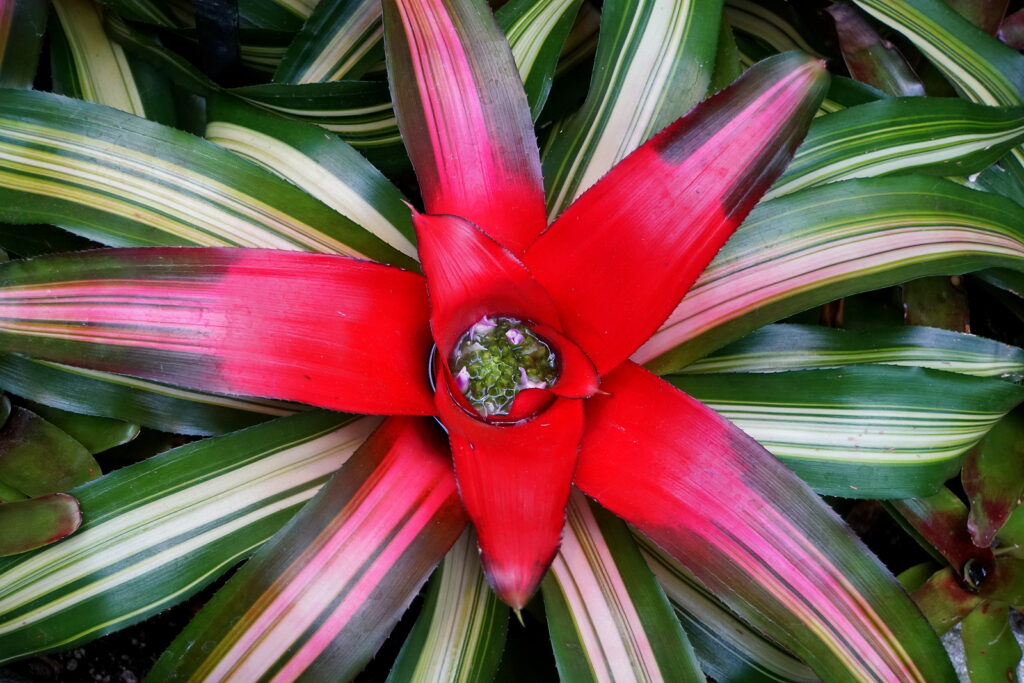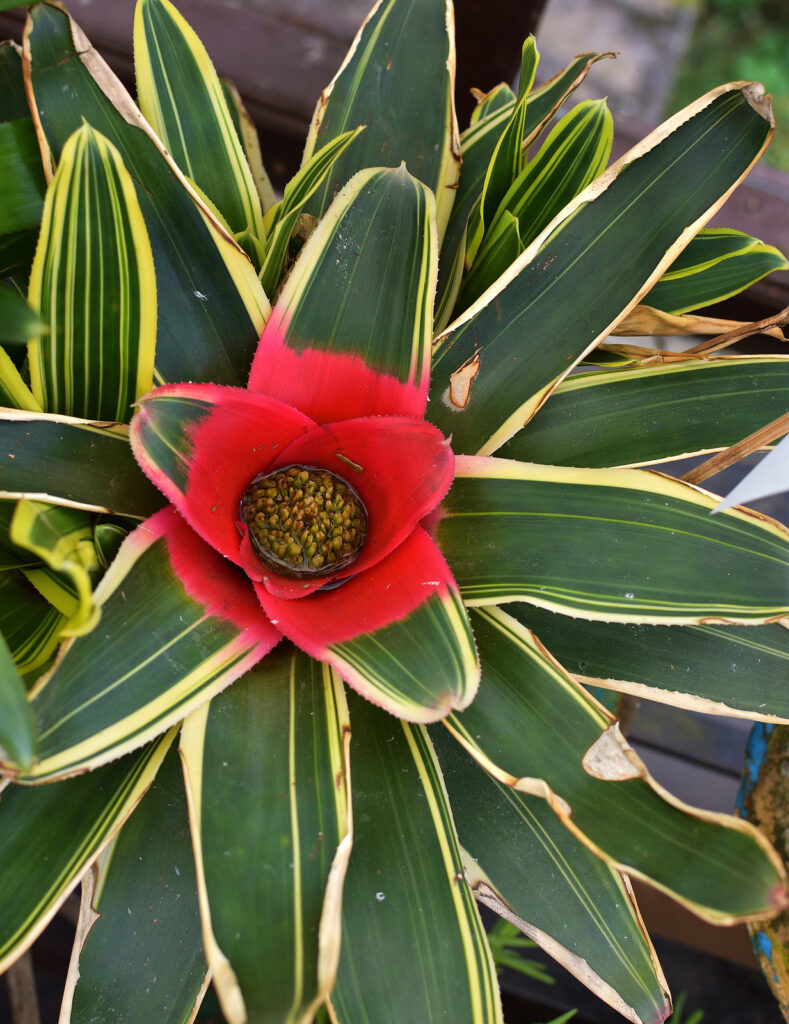Neoregelia is a genus of tropical plants belonging to the bromeliad family, known for its striking foliage and rosette shape. These plants are native to South America, particularly Brazil, and are popular for their colorful, often variegated leaves, which can feature a range of vibrant hues like red, pink, purple, and green. Neoregelias also produce small, bright flowers that bloom from the center of the rosette, though the foliage is often the main attraction.
Neoregelia Description
- Foliage: Neoregelias are best known for their stiff, glossy, strap-like leaves arranged in a rosette. The leaves are often marked with colorful patterns or bands. Some varieties feature bright central foliage that intensifies in color when the plant is ready to bloom.
- Flowers: While the flowers are not the main feature, they emerge from the center of the rosette and are often short-lived but visually striking.
- Growth Habit: Neoregelias are typically small to medium-sized, with compact growth, making them ideal for various uses in garden design or as houseplants.

Neoregelia Uses in the Garden
- Tropical or Subtropical Gardens: In warm climates (USDA Zones 9-11), Neoregelias can be grown outdoors year-round as ground cover, in rock gardens, or nestled among other tropical plants for added texture and color.
- Container Planting: They thrive in pots, making them versatile for patios, balconies, or as accents in outdoor spaces. Grouping several Neoregelias together can create a dramatic visual effect.
- Terrariums and Vertical Gardens: Their ability to grow in minimal soil makes them perfect for terrariums or vertical gardens, where their vibrant colors and texture can create focal points.
Neoregelia Uses as a Houseplant
- Low Maintenance: Neoregelias are relatively easy to care for. They require occasional watering in the central cup (the rosette), and they don’t need frequent fertilization. This makes them an excellent option for beginners or people looking for a low-effort yet striking plant.Neoregelia is a genus of epiphytic and terrestrial bromeliads grown for the striking coloring of their lease and bracts when flowering. Neoregelia’s usually spiny-margined leaves are borne in rosettes; colorful bracts surround very small flowers at the center of the bracts.
- Indoor Decor: Neoregelias are popular houseplants due to their low maintenance and stunning appearance. They thrive in bright, indirect light and can be placed on shelves, in hanging baskets, or near windows where they get filtered sunlight.
- Air Plants: Like many bromeliads, Neoregelias can be grown as air plants, meaning they don’t require soil. Their ability to absorb water and nutrients through their leaves makes them great candidates for mounting on walls or placing in decorative holders.
Neoregelia may bloom at any time during the year. The changing color of the inner rosette or leaf tips signals the appearance of a flower. The compact heads of violet or blue flowers are not long-lasting, but the foliage color remains for several months.
Neoregelia is a genus of more than 100 species of evergreen, perennial bromeliads. Neoregeliasis native to coastal scrub, woodlands, and rainforests in South America.
Get to Know Neoregelia
- Plant type: Epiphytic or terrestrial bromeliad
- Growing zones and range: Zones 13-15
- Growing temperature: Tolerates 50° to 85°F (10° to 29°C) range.
- Height and width: 8 to 16 inches (20-40cm) tall, 16 to 24 inches (40-60cm) wide depending on the variety
- Foliage: Spiny margined leaves are brone in rosettes; large sheathes enclose the scape and its bracts
- Flowers: Umbel-like compact infloresences nestle in the center of each leaf rosette; the changing color of the inner rosette or leaf tips signals the appearance of a flower.
- Bloom time: Bloom at any time during the year.
- Uses: Houseplant, tropical plant
- Common name: Fingernail plant
- Botanical name: Neoregelia
- Family name: Bromeliaceae
- Origin: South America

Where to Plant Neoregelia
- Light indoors: Bright light, with direct winter sun, from eastern or western exposure. Foliage color is enhanced full light. Air circulation is important.
- Light outdoors: Plant in an open site with partial shade
- Soil indoors: Pot Neoreelia in an epiphytic bromeliad mix.
- Soil outdoors: Grow Neoregelia in gritty, leafy soil.
When to Plant Neoregelia
- Set Neoregelia outdoors in a tropical or subtropical garden any time of the year.
Planting and Spacing Neoregelia
- Space Neoregelia 16 to 24 inches (40-60cm) apart depending on the variety.
How to Water and Feed Neoregelia
- Water: Water Neoregelia freely during the growing period. Keep fresh water in the leaf cup. Keep the growing medium slightly moist. Mist occasionally. Optimal humidity is 45% to 60%
- Feeding: Apply a low nitrogen liquid fertilizer monthly during the growing period. Avoid oil-based products such as fish emulsion. Spray foliar fertilizer on the leaves, add to water in cup, or apply to growing medium after watering; never feed a dry plant.
Neoregelia Care
- Neoregelia has no specific rest period; growth continues slowly throughout the year.
- Neoregelia dies within 2 years after flowering.
Growing Neoregelia as a Houseplant
- Neoregelia carolinae and N. x marmorata are often grown as houseplants.
- Neoregelia need bright to direct light, an average temperature, and medium to high humidity.
- The potting medium can be kept relatively dry and the water cup in the center of the rosette should be filled with fresh water.
- Fertilizer can be applied once a month throughout the year.
Neoregelia Pests and Diseases
- Neoregelia is susceptible to scale insects and mealybugs.
- Bacterial soft rot and leaf spot and a variety of fungal leaf spots can occur.
Neoregelia Propagation
- Sow Neoregelia seed in warm soil in spring.
- Separate offsets in spring or summer.
Neoregelia Varieties to Grow
- Neoregelia carolinae, blushing bromeliad. Epiphytic bromeliad produces 16 inch (40cm) long, spiny green leaves, with inner rosette changing to red-purple.
- N. carolinae ‘Meyendorffii’. 5 inch (13cm) long, olive green leaves with brown bands on the undersides; center rosette deepens to burgundy.
- N. carolinae ‘Tricolor’. Variegated leaves of white, pink, and green; center leaves change to red.
- N. marmorata x spectabilis, marble plant or fingernail plant. Bears 16 inch (41cm) long, mottled leaves with red tips.
- N. spectabilis, fingernail plant. Two-tone leaves, green with red tips on the top and gray-striped on the underside; center rosette changes to purple before blue flowers appear.



